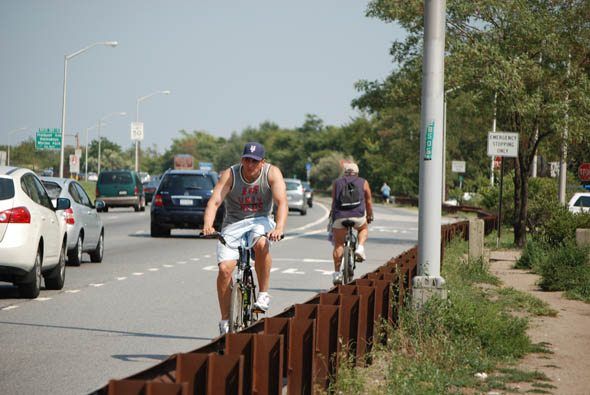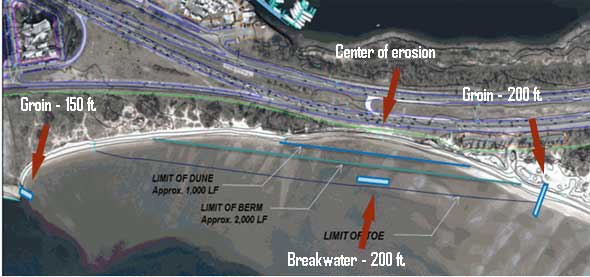Plumb Beach Repairs Continue In April, Parking Lot To Be Closed And Bike Path Detoured Through Summer

The U.S. Army Corps of Engineers has announced plans to kick off the second phase of construction on Plumb Beach in April, but say they’ll have to close the parking lot and detour the damaged bike path until the end of the year.
The Army Corps awarded a $2 million contract to a Long Island-based construction firm in February, clearing the way for work to begin on the construction of two terminal groins at the ends of the eroded beach near the parking lot, as well as an offshore breakwater to weaken tidal forces against the beach. The plan includes planting of 1.2 acres of beach grass and other vegetation that will hold in place sand placed there as part of the first phase, which was completed in late 2012.

But the work includes bringing in heavy machinery and other equipment, as well as scores of enormous boulders. To accommodate the construction, the Army Corps is turning the parking lot into a staging area, and creating a detour of the bike and pedestrian path to keep the greenway accessible.
The closure and detour will continue for the duration of the work, which they expect to be completed before the end of December.
Cyclists who have bemoaned the condition of the bike path, a segment of which crumbled into the sea in a 2009 nor’easter, won’t have much to rejoice about, though. The Army Corp may create a detour, but it will still lead into the damaged portion of the path which is not yet set for repairs, a representative told Sheepshead Bites.
“Part of while we’re there, we’ll clean up the area where [the bike path passes, which has been full of sand since Superstorm Sandy], but it’s not really part of it to repair or improve [the broken section of bike path],” explained Army Corps spokesperson Chris Gardner.
Gardner said the detour will begin just east of where the path is currently damaged, straightening it out from where it currently curves toward the beach and around the parking lot. It will now stay along the Belt Parkway and go through the northern edge of the parking lot.
“They’re going to cut it through the parking lot so that people can still use the bike path,” Gardner said. “They have to keep the bikers out of the area where the heavy equipment will be.”
It does little do solve the ongoing problem of cyclists resorting to a perilous ride on the Belt Parkway to avoid the 150-foot-long sand trap created by the destroyed path.
Construction of the groin and breakwater – the most complicated part of the job, according to Gardner – will begin in July to accomodate horseshoe crab mating season. But the site will be prepared and stones moved onto the site in April, along with the planting of vegetation on the newly constructed sand dunes. Fences will also be installed to trap sand from blowing landward.



